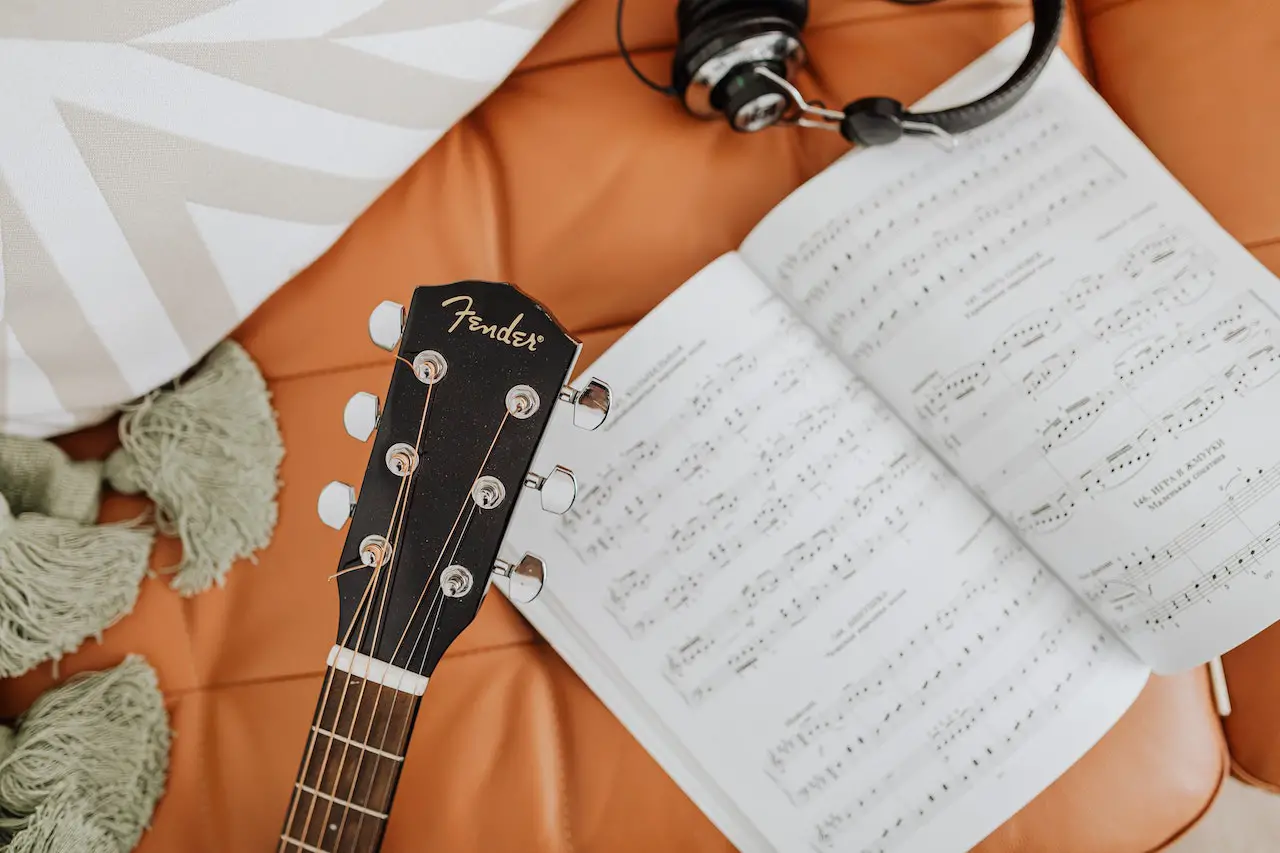Ghost Note vs. Dead Note
A ghost note is a note that is played very softly between primary notes during a song. They are played at the same tempo as the rest of the song.
Ghost notes can be very faint (meaning they are audible but barely heard). Ghost notes can also be played where there is no melodic sound, but you still hear a percussive sound in rhythm with the song’s tempo.
A dead note is a muted note that can be intentionally played at the same tempo as the rest of the song. A dead note is muted so that there is no discernable pitch or tone to the note being played (they are marked with an x in the guitar tablature).
A dead note can also be played accidentally in a guitar chord if the incorrect finger pressure is applied against the fretboard.
As someone who has played guitar and bass for many years, I can confirm that playing with ghost notes and dead notes can spice up your playing and create an incredible new dimension for your playing ability.
In this article, we will go over the meaning of ghost notes vs. dead notes, if ghost notes vs. dead notes are bad (and in what context), how to create ghost notes and dead notes, and what the point is of playing ghost notes.
There will also be links to examples of playing ghost notes vs. dead notes, learning to play ghost notes, and stopping a note from being a dead note.
1. The Meaning: Ghost Note vs. Dead Note
A ghost note is called this because the note is still played at the same rhythm the rest of your chords or notes are being played at.
They can still have a slight melodic sound that is very faint, or they can have a simply percussive sound. A dead note is called this because there is no sound to the note (due to the note being muted).
2. Are They Bad? Ghost Note vs. Dead Note
A ghost note and or a dead note are not necessarily bad. These notes can be good or bad based on if they are helpful or not in the context of the song you are playing.
A ghost note is not bad per se unless the note being played is not in the key of the song you are playing. While a ghost note is very faint and played softer than regular notes, it will be noticeable if it is out of key with the rest of the song.
A dead note can be good or bad. A good dead note is intentional, and a bad dead note is accidental.
An example of a bad dead note is when you are playing a chord on the guitar with three fingers, and one of the three notes does not ring clearly because the finger you are pressing against the fretboard is not positioned correctly. This will result in the chord not being played correctly.
An example of a good dead note is a note (or notes in the case of a chord) would be intentionally applying no pressure against the strings and frets and strumming or plucking the strings in the same rhythm you are playing the rest of the song with.
This will create a percussion effect that, if played at the proper tempo with the rest of your song, will have a cool-sounding impact. However, playing a dead note with your left hand on the following regular note you intend to play will make the next chord or note progression easier.
3. Causes: Ghost Note vs. Dead Note
To make a ghost note, simply place your finger lightly on the guitar’s fret and puck the string lightly to create a faint sound.
There is no standard explanation of how hard or softly to press the string against the fret or how softly to pluck the string. Play and experiment as often as needed until you can make the note audible while still sounding faint (or ghostly).
To make a dead note, simply place your finger on the fret of the string and pluck or strum the string at the same tempo you are playing the rest of the song in. Do not apply any pressure against the fret.
Simply rest your finger there and pluck the string at the same tempo you are playing the rest of the song. This will create a percussion sound with no note sound, the way a ghost note makes a sound (no note is heard at all).
4. Sample Sound: Ghost Note vs. Dead Note
Here is an example of how you can play ghost notes with your guitar. These ghost notes are more of a muted effect, but at specific points in the video, you can hear the melody of the notes that are being played very softly and lightly, thus being called ghost notes.
This guitarist recommends playing notes one right after another to create a ghost-like effect. However, as you watch this, you will notice that there are points during his playing where certain notes are played with more pressure against the fretboard than others (which also is an excellent example of creating ghost notes:
This YouTube video is a great tutorial on how to eliminate unintentional dead notes when playing your guitar chords:
What Is the Point of Ghost Notes?

They indicate a note played softly between accented beats
The point of a ghost note is to lightly and/or softly mix up a melodic sound in your playing between the regular notes and chords you are playing on the guitar. Ghost notes create an excellent melodic sound to them.
During different parts of songs, a ghost note may have a light or airy feel. If you feel a ghost note may create a certain mood or effect at a certain point, feel free to add one and see how it comes out. Ghost notes are fun to experiment with to enhance the overall sound of the song you are playing.
Also Read: Gain Vs. Distortion Vs. Overdrive: Tone Difference & Usage
How Do I Learn Ghost Notes On Guitar?

You should practice more and more to learn ghost note on guitar
Please keep in mind that you may need to experiment with this process of creating ghost notes until you get the feeling of exactly how softly you need to apply pressure to the string and fret and how lightly to create the desired effect.
This can take a little bit of practice. Once you can make the same ghost note sound precisely how you want to, you are ready to move on to the next step.
Next, find a song with notes you are playing in a one-two there four rhythm. When playing the song, try playing every second and fourth note on a one, two, three, four count by applying the ghost note technique you used in the first step.
Finally, use a metronome and set it at a count of approximately 60 beats per minute (you can easily find a free metronome that you can download to most smartphones at little to no cost).
Start to play the song on a one, two, three, four count in rhythm with the metronome while ensuring that you can still play the ghost note with the sound effect you want while still staying in rhythm.
Continue to run through these steps until you can play the ghost note with the sound you want while also playing it in rhythm with the rest of the song.
Once you have done so, you can mix up your ghost notes by playing them on the one and three count of the one two three four count of the song you are playing if you would like to do so.
How Do You Stop Dead Notes on a Guitar?

You can prevent dead notes by curling your knuckles properly
To prevent dead notes, simply apply the right amount of pressure against the fret for the note you are playing to ring audibly and clearly.
You can also stop dead notes by curling your knuckles properly when playing your chords (please see the video link above in this article, The No 1 Reason; Why Your Guitar Chords Sound Like Poo-Poo)
Another potential cause of dead notes could be the guitar’s action (how close to the fretboard your strings are). You may want to consider adjusting the action so that it is lower to the fretboard, thus requiring less pressure to play the chords you want.
Unintentional dead notes can also be reduced or eliminated by simply moving the guitar strap higher toward your head or lower toward your waist, which will change the position of your arms. It would be best to experiment with different positions until you find the best one.
Also Read: High E Vs Low E Guitar Strings: Why Are There 2 Of Them?
Conclusion
This article covered the differences between ghost and dead notes and defined each. We also covered whether ghost or dead notes are bad and in what context they can be good or bad.
We went over the point of ghost notes and explained how they could spice up your playing. We also provided samples of ghost notes and dead notes and went over instructions on how to play both ghost notes properly and dead notes (and how to avoid playing unintentional dead notes as well).





